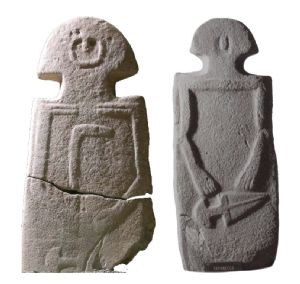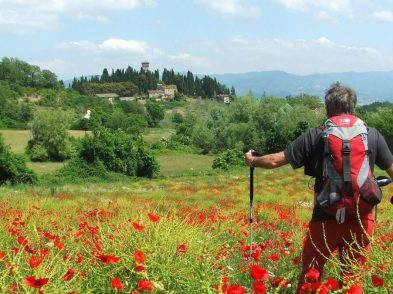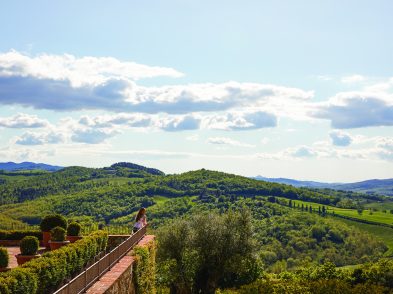Legend has it that the narrow, tortuous paths, or vicoli, that lead the way up to the Castle of Piagnaro in the town of Pontremoli are haunted by a wolf-like creature known by locals as the lupo mannaro. Locals say that the only way to avoid the attack of a lupo mannaro is to stare at it straight in the eyes or climb three stairs. Carrying a rooster around also helps, since this feathery friend announces the arrival of daylight, something that the lupo just can’t deal with.
Stories such as these intrigue residents and visitors alike in the historical region of Lunigiana, located in the midst of the Tuscan Apennines. Lunigiana derives its name from Luni, a once-powerful Roman port colony (now located in the region of Liguria) that rose at the delta of the river Magra and held considerable influence, thanks to its strategic location. At the height of its medieval glory, Lunigiana encompassed the entire Magra and Vara valleys, the Gulf of La Spezia, Cinque Terre and the Riviera of the Apuan Alps. Nowadays, the area known as Lunigiana is considerably smaller, comprising only 14 municipalities in the Magra Valley.
A tour of Lunigiana makes a perfect long weekend trip for those who enjoy the untouched rugged nature of the Apennines, the area’s local food and folklore, and the well-preserved medieval constructions along the Magra.
Head for the Santa Maria Novella train station with the resolution of a modern-day explorer eager to take in a lot of history, fresh air and calories. Hop on one of the five daily trains that go directly to Pontremoli from Florence. Enjoy the scenery that unfolds as the train heads north, first towards the coast, passing the cities of Pisa, Massa, Carrara (check out the marble caves and the Apuan Alps on your right) and brace for a sharp turn as the train changes route and enters the valley that will take you straight into the heart of Lunigiana. Pontremoli is the final stop of your journey, after a two-hour-and-40-minute ride.
Pontremoli (from the Latin ponte tremulus, ‘trembling bridge‘), which has a beautifully preserved medieval center, is located at the northernmost point of Lunigiana. Its train station is quite convenient, only a 10-minute walk to the ancient city center.
As the bells of the city’s most beloved tower, il campanun, announce the time, taste the secret mixture of the bianco oro aperitivo in the historic bar Da Roberto, in piazza del Duomo. After signing the bar’s famous guest book filled with messages from world travelers, head to Trattoria Norina on via Garibaldi for a taste of local specialties and make sure you order a plate of testaroli. This typical and tasty Pontremolese meal is made from a mixture of flour, salt and water cooked in big cast iron testi, the shallow pans used to make the crêpes. The final product, which looks very much like a spongy crêpe, is then cut into little rectangular pieces and boiled for a few seconds. Add fresh pesto lunigianese, olive oil and parmigiano and the result is a simple but unforgettable dish that leaves you dreaming about your next testaroli encounter (see http://terraeluni.com/ricette.php to try it in your own kitchen).
Next, explore the several churches that follow the route of the via Francigena, then head up the vicoli (only during daytime, mi raccomando, unless you want to test your luck with the lupo mannaro!) to the Piagnaro Castle, which houses the largest exposition of Stele Statues from Lunigiana (see TF 136 for details). The castle also operates as a hostel (18 euro per night); those less adventurous or with a bigger budget will find dozens of agriturismi in the area ready to offer unique amenities and local hospitality.
On Saturday morning, walk through the downtown market and take a minute to fill your senses with its aromas and sounds before heading to your next destination: the train ride down the valley to Aulla, which takes only 20 minutes. Almost completely destroyed during World War II, Aulla’s medieval center is practically non-existent. Besides the imposing presence of the Brunella Fort, the city resembles any other modern center. Nevertheless, Aulla’s strategic location makes it a perfect departure point for nature lovers who want to explore the National Park of the Tuscan-Emilian Apennines.
Unfortunately, public transportation is not much of an option, so if you want to get a foot into nature, you’re going to have to rent a car in order to explore. Or you can book an evening at the Azienda Agricola Montagna Verde (http://www.montagnaverde.it), which is located in Licciana Nardi, about 18km from Aulla (price varies from 45 to 60 euro half/full pension per night), and offers transfer services from the train station. Besides its excellent prices and foreigner-friendly environment, visitors can enjoy hiking, fishing and mountain biking in the midst of the breathtaking natural park. You can also relax by the pool and taste the delicious piatti lunigianesi prepared with the farm’s own organic products. Montagna Verde’s medieval setting is practically intact, including a restored tower that dates to the sixth century. Thinking of taking a stroll at night? Just beware of the spirits that roam the forests, such as a mysterious oak tree, said by local legend to be used as a meeting point for witches in the surroundings.
What else to eat? Lunigiana’s cuisine is a mixture of different regional influences yet features local products connected to the contadina tradition. For example, the pesto lunigianese is similar to the pesto genovese, although it is prepared with locally made pecorino, basil leaves, local olive oil and garlic (no pine nuts). While the area’s other traditional foods, such as porcino mushrooms, chestnut flour (farina di castagne) and chestnut honey (miele di castagno), are known throughout Italy, don’t leave the Lunigiana without tasting its famous torta d’erbi, a pie made with local vegetables and prepared in the region’s traditional iron testi.








